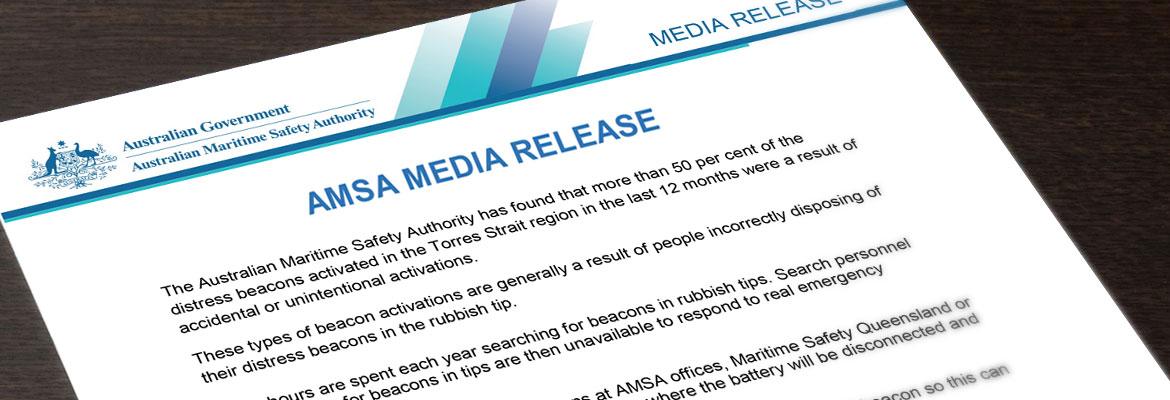
Queensland recorded the highest number of distress beacon activations in the country in the past 12 months with 27 per cent of nearly 1500 beacon activations detected in Queensland. Most of these were from recreational vessels.
Queensland also has the highest number of inadvertent activations relating to mishandled or malfunctioning beacons in the country, with these incidents representing 36 per cent of all incidents in the state in the 12 months up to October 2013. The number of inadvertent beacon activations Australia wide increased by nine per cent from 474 to 521 between the 2011-12 financial year and the 2012-13 financial year.
Activations relating to real distress situations accounted for 20 per cent of all incidents in Queensland.
AMSA's Emergency Response Division General Manager John Young encouraged distress beacon owners to take the simple step of registering their beacon to help prevent emergency resources being tasked unnecessarily, as well as ensuring help arrives as soon as possible in an emergency.
'Having your beacon registered means we can contact you or a relative or friend if your beacon is activated and determine the nature of distress, your location and also what your boat, vehicle or plane looks like,' Mr Young said.
'This helps us to get help to you as soon as possible and also ensures the right assets are tasked such as an aircraft fitted with the necessary medical equipment.
'Registering your beacon is also important in case your beacon is activated accidentally. False alarms require the use of emergency response resources and personnel, which may be diverted from a genuine emergency.
'If your beacon is registered, AMSA can contact you as soon as we detect your beacon and quickly determine if an emergency exists or if your beacon has been inadvertently activated.'
Australia wide, about 28 per cent of distress beacon activations are from unregistered beacons. Assistant Commissioner Alistair Dawson from the QPS, Operation Support Command said on the spot fines apply for misuse and for not carrying a distress beacon when required.
'Incidences such as travelling in open waters outside two nautical miles, producing an expired distress beacon in waters when required to carry one, failing to register a beacon if required to carry one and activating a beacon when not in distress all carry fines, Assistant Commissioner Dawson said.
'In open waters it is a requirement to have a current distress beacon. They normally expire after five years but some can be serviced to extend their life.
'Distress beacons must be registered with AMSA with information provided of the current owner, vessel details and emergency contacts, as well as the registration sticker affixed and in date,' Assistant Commissioner Dawson said.
Registering your beacon is free and only takes a few minutes. It can be done online on AMSA's website or over the phone. Trip details can also be logged as well as a photo of your vessel.
AMSA's Rescue Coordination Centre, which is responsible for coordinating aircraft, vessels and emergency services personnel to assist when a distress beacon is detected at sea, land or in the air, responded to 408 incidents involving distress beacons throughout Queensland between October 2012 and October 2013.
A total of 82 incidents related to a real distress situation, while 150 incidents were inadvertent activations due to mishandled or malfunctioning beacons.
Of these 408 incidents, 33 incidents were traced back to out-dated 121.5MHz distress beacons. 121.5MHz beacons were phased out in 2009. AMSA regularly responds to 121.5MHz beacons activations only to find them in a moored boat or disposed in a tip or household bin.
Beacons can be registered for free online or by phoning 1800 406 406. Information on beacon disposal is also available on AMSA's website.
Fast facts
- Australia has the highest distress beacon ownership per capita in the world.
- Queensland recorded the highest number of distress beacon activations in the country in the past 12 months with 27 per cent of nearly 1500 beacon activations detected in Queensland.
- Queensland has the highest number of inadvertent activations relating to mishandled or malfunctioning beacons in the country, with these incidents representing 36 per cent of all incidents in the state in the 12 months up to October 2013. Activations relating to real distress situations accounted for 20 per cent of all incidents in Queensland.
- At the end of September 2013, there were 295,298 distress beacons registered in AMSA’s database. More than 94,000 distress beacons or around 31 per cent are registered in Queensland (compared to 60,000 or around 20 per cent in New South Wales).
- AMSA's Rescue Coordination Centre deals with approximately 8000 incidents a year (beacon activations, searches, medical evacuations). These incidents may be responded to in conjunction with other agencies such as police, volunteer marine rescue, and rescue helicopter services.
Media enquiries: AMSA Media - Lisa Martin 0429 504 267 or 1300 624 633.